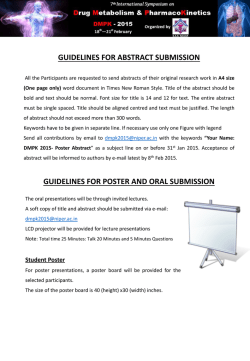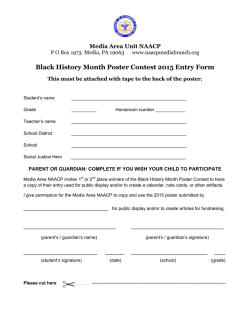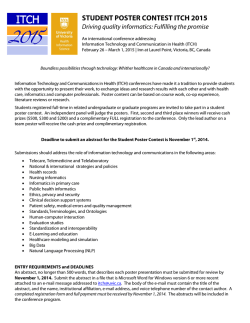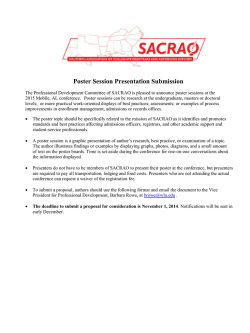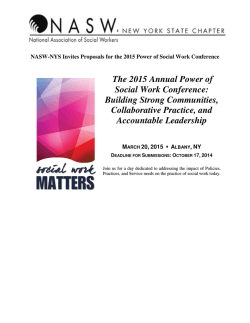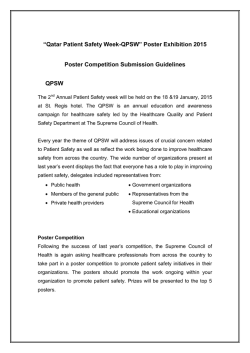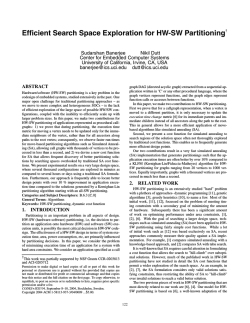
2015 poster competition - American Statistical Association
2015 Statistical Poster Competition Fact Sheet Sponsored by The Connecticut Chapter of the American Statistical Association Deadline for submission: April 1, 2015 Overview: Posters will be judged in four grade categories: Ø K - 3 Ø 4 - 6 Ø 7 - 9 Ø 10 - 12 Winning schools and students will be awarded certificates as well as monetary prizes. First place teams will receive $100, second place teams $75, and third place teams $50. Selected posters will be forwarded to the 2015 American Statistical Association National Poster Competition for the chance to win more prizes! Important dates: Ø The deadline for submission is Wednesday, April 1, 2015. Ø Teachers with winning posters will be notified by Monday, April 13. Ø An awards ceremony will be held on Saturday, April 25 at University of Connecticut. Posters must be mailed or dropped off by Wednesday, April 1 to: Marianne Messina Bristol-Myers Squibb 5 Research Parkway Wallingford, CT 06492 Please share this information to your colleagues and post the announcement on your bulletin board. Check out last year’s winning posters! http://www.amstat.org/chapters/Connecticut/home/Poster/poster_judging_2014.htm and click link for “Winning Posters 2014” at bottom of webpage. Sincerely, Marianne Messina, Jennifer Boyko, and Valerie Nazzaro 2015 Connecticut ASA Poster Competition Co-chairs For more information on the CT Poster Competition, please don’t hesitate to contact [email protected] [email protected] [email protected] Poster Contest Rules One separate entry form must be completed and paper clipped to each poster and the writing must be legible. • Any application form which cannot be read will result in disqualification. • Any poster which does not have an accompanying application form will result in disqualification. Please read these rules carefully • Posters must measure between 18 and 24 inches high and 24 and 30 inches wide. • Any layers of paper on posters must be affixed securely. • Any weight paper is permitted. • Posters must be the original design and creation of the entrants themselves. • Computer graphics may be used. • Subject matter is the choice of the participant(s) or their classmates. • An example of the original data, brief descriptions of method of collection and purpose of the experiment must be taped to the back of the poster. Cite references for published data. Do not show data tables on the front of the poster. Reading off numbers is not the point of the display. • Paperclip (do not glue nor staple) the entry form to the front of each poster. Each poster must have one accompanying entry form. Posters without entry forms will not be judged. • Be sure the poster itself gives no information that identifies the team or school. • Students may work individually or in teams: Ø For those in the K-3 category, there is no restriction on the size of the team; it may be as large as the entire class. Ø For other grade categories, the maximum number of team members is 4 students. Ø For teams with members from different grades, the highest grade determines the entry category. • Except for the K-3 category, more than one graph is required. In submitting a poster, students agree that the poster may be displayed at the ASA's Joint Statistical Meetings, featured in its publications, and posted on the ASA or CT Chapter website. All entries become the property of the sponsors and cannot be returned. Guidance on Poster Content • A poster must be able to stand alone - without a narrator to tell the story or a report to discuss the data. Not only must viewers understand the individual graphics, but they must also understand the relationships among the graphs, and how the graphs address the central question. • Focus - the central idea or conclusion should be the most prominent feature of the poster. • Be consistent. Use graphs consistently to present the same types of data. Consistent use of colors and patterns is particularly important (e.g., data for girls is green in every graph where it appears). Use colors with restraint; colors should enhance recognition of the conclusion. If two graphs will be compared, make the size and axis labels consistent. • Each graph should have its own title, labels, and legend. marked on axes and axes should be scaled appropriately. • Use an informative title. The title may convey the major conclusion to be drawn from the data or ask a question which draws the viewer in. • The poster is not a report and not an art project. The central focus should be on the graphs, and the graphs should convey the central message. Excessive artwork should be avoided. Data tables and detailed written explanations should not appear on the front of the poster. • Do not have too many graphs - If the poster contains more than five graphs then it almost certainly has too many. Usually three to five graphs suffice - some show what data were collected and others summarize the conclusions. Each graph on the poster should convey new information about the data that cannot be seen in the other graphs. It is generally not a good idea to plot the exact same data two different ways (i.e., a pie chart and a bar chart). • Sample sizes - Percentages are often an appropriate tool for comparing different groups of data; however it is important to always report group sizes. For example, percentages would be misleading if a poster says that 75% of girls and 60% of boys like pokemon, and omits to report that 40 boys were surveyed, but only 4 girls were. • Use pie-charts cautiously. It is hard to compare one pie chart to another or compare little slices to big slices. Often the data that is shown in pie charts is meaningless. For example, a pie chart of the number of the number of kids that won a contest in each grade doesn’t take account of the number of kids in each grade (see comment on sample sizes above). Bar charts are generally preferred over pie charts. Units should be correctly Judging Criteria These are the criteria that the judges will use: • Clarity of message - The poster clearly demonstrates the important relationships, patterns, and obvious conclusions from the data, even without the explanatory paragraph on the back. There is a central message and it is presented prominently and clearly. • Appropriateness of graphics for the data - The appropriate data were collected to address the question being studied, and the graphs appropriately present the data. • Overall impact - The poster is eye-catching and visually attractive (uncluttered, neat, and well-organized). The poster is creative and interesting. The poster draws the viewer in to investigate the individual graphics. • Creativity – The poster topic and presentation show originality. The topic draws the viewer in and piques their interest to learn something new from the poster. You can see examples of winning posters from previous Connecticut competitions on our web site: http://www.amstat.org/chapters/Connecticut/home/Poster/poster_index.htm http://www.amstat.org/chapters/Connecticut/home/Poster/poster_judging_2014.htm For more information on the national competition, please visit the national website: http://www.amstat.org/education/posterprojects/index.cfm. CT Chapter of the American Statistical Association 2015 Statistical Poster Competition Deadline for submission: Wednesday, April 1, 2015 ENTRY APPLICATION FORM A separate entry form must be completed and paper clipped (not glued or stapled) to each poster when the poster is formally submitted. Please make certain that the poster itself gives no information that identifies the team or school. Grade category: K-3_______ 4-6_______ 7-9_______ 10-12_______ For a team entry, the category is determined by the highest grade of any member. Please type (Clarity is absolutely essential!) Title of Poster: _________________________________________________________________________________ Full Name of School: _________________________________________________________________________________ Address: _________________________________________________________________________ City/State/Zip:______________________________________________________________________ WINNING TEACHERS WILL BE NOTIFIED VIA EMAIL OR TELEPHONE THEREFORE COMPLETE ALL INFORMATION BELOW: PRINT LEGIBLY (large block letters preferred) Faculty/Advisor Name **: __________________________________________ email **: _______________________________________________________ Signature: _________________________________________ Phone **: ( ) _____ - ________ ** Above fields must be fully completed. If not, the poster will not be judged. Please give student's name(s) and grade level(s) below. Attach a separate list of all students if there are more than four team members (Note: This is only allowed for Grades K-3. All other grades must not have more than 4 members within a team.) For winning posters, the names provided below will be as they are noted on the Award Certificates, therefore make sure full names are given and these names are legible. 1. _________________________________________________________ Grade _____ 2. _________________________________________________________ Grade _____ 3. _________________________________________________________ Grade _____ 4. _________________________________________________________ Grade _____ I/we verify that this is my/our original work, and I/we understand that it will become the property of the American Statistical Association as a work for hire under the copyright act. In submitting a poster entry, students agree that the poster may be displayed at the ASA’s Joint Statistical Meetings, featured in its publications, and included on its web site at www.amstat.org and www.amstat.org/chapters/Connecticut/home/index.htm
© Copyright 2025
